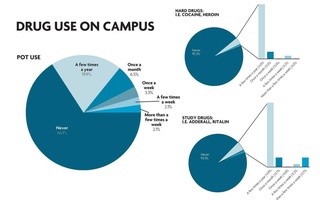In his new book “Flash Boys,” Michael Lewis explains how high frequency traders are rigging the American stock market. It was an instantaneous hit; according to Malcolm Gladwell “in the hands of Michael Lewis, anything is possible.” Indeed, Lewis has accomplished the impossible task of mistaking the great financial revolution’s protagonist for its antagonist.
“Flash Boys” follows Brian Katsuyama, a Canadian trader in New York who has found it harder and harder to trade for his mutual fund clients. He believes high frequency traders and their compliant stock exchanges are “rigging” the stock market. Katsuyama then starts his own exchange, IEX, which promises a “fair playing ground” for investors and shuns high frequency traders.
The book and its attendant publicity remind me of Ezekiel 25:17, with its Manichaean dualism. In Lewis’s narrative, High Frequency Trading is the evil man, Katsuyama’s mutual fund clients are the righteous and the weak, and Katsuyama’s new exchange is the shepherd that protects the righteous from the evil.
Spell-binding this may be but true it is not. Michael Lewis depicts the high frequency trading industry as a monopolistic, rent-seeking entity called “Scalpers, Inc.” He talks about a particularly unsavory market practice, “latency arbitrage,” implying that high frequency trading is all about hoodwinking the common folk. In actuality, latency arbitrage is just one of dozens, if not hundreds, of high frequency trading strategies, most of which make it cheaper, not more expensive, for investors to trade. High frequency trading is also neither monopolistic nor large. Michael Lewis places an upper bound estimate of total industry revenue at $22 billion, a rounding error compared to the $1.2 trillion American financial sector. By contrast, the “small investors” in Lewis’s narrative include hedge fund manager David Einhorn, whose personal wealth exceeds the market value of even the largest high frequency trading firm.
High frequency traders are making relatively little despite their massive market impact; they are the stock market’s new middlemen, and they charge a fraction of what the old middlemen did. If a small investor wanted to buy 100 IBM shares in 1994, he had to pay around $10 in brokerage fees, and at least six dollars in bid-ask spread costs to a specialist on the floor of the New York Stock Exchange. Today, the same trade will cost $1 in bid-ask spread thanks to the tight spread that high frequency traders provide, and the investor may not have to pay commission at all. High frequency traders provide low-cost trading options to small investors by adopting better pricing models and charging more for large orders from large investors. David Einhorn and Katsuyama’s clients might feel indignant that high frequency traders won’t allow them to trade at the same cheap price that the old middlemen provided, but their frustration is merely the indication of a more sophisticated and responsive market.
Michael Lewis believes that the stock market is rigged because an increasing number of new exchanges have amended their rules to appeal to high frequency traders. Lewis neglects to mention, however, that this healthy competition for high frequency trading volume directly results in a lower trading cost for investors, as the exchanges compete to lower the exchange fees. From this perspective, Katsuyama’s IEX is a retrograde enterprise. His exchange charges traders 18 cents per 100 shares, whereas NYSE and NASDAQ, two of the largest exchanges, charge between four and five cents. This can make trading on IEX more expensive than trading on NYSE and NASDAQ for retail investors.
Whether or not Katsuyama’s IEX brings value to small investors, he will be an innovator, and innovation is great in the nascent industry of electronic trading. The quality of our markets won’t suffer when innovators like him present alternative, though outdated, ways of doing things. Rather, our markets suffer when a popular writer like Michael Lewis reduces a complex phenomenon into a simplistic morality tale of good versus evil. Those who read his book without prior knowledge will pressure the SEC to adopt rules that will hurt the market and investors. Reality-free regulation has often flopped: Look at the Canadian experiment that made trading harder and more expensive for small investors by levying fees on order flow.
I venture to present my own simplistic morality tale: the small investors are the righteous and weak. Bad regulation, encouraged by Lewis’s misinformation, is the evil. And the high frequency traders will lead the righteous through the valley of darkness that is the stock market.
Jonathan Z. Zhou ’14 is an applied mathematics concentrator in Eliot House. His column appears on alternate Mondays.
Read more in Opinion
We Need To TalkRecommended Articles
-
Peabody Museum Acquisitions.The Peabody Museum received last week a box of Pueblo Indian relics from Arizona. Dr. Frank Russell, instructor in Anthropology,
-
 At the Top of Their Game
At the Top of Their Game -
Financial FolliesAs the debate continues, many Democrats and Republicans are trying to outdo each other to see who can seem “toughest” on reform, but in the process, they are failing to understand which regulations really need to be in place for the economy to function well.
-
 Drug Use on Campus
Drug Use on Campus -
At TEDxBoston, Harvard Affiliates Showcase 'Culturomics,' 'Astronomical Medicine'Three Harvard School of Engineering and Applied Sciences affiliates explored digitized history and the intersection of astronomy and medicine at a Boston offshoot of the popular TED Talks on Tuesday.
-
Congress Passes Brown's Insider Trading BillIn a sweeping 417-to-2 vote Thursday, the House of Representatives passed legislation introduced by Sen. Scott P. Brown that bans members of Congress from participating in insider trading and requires them to disclose all personal stock transactions.













